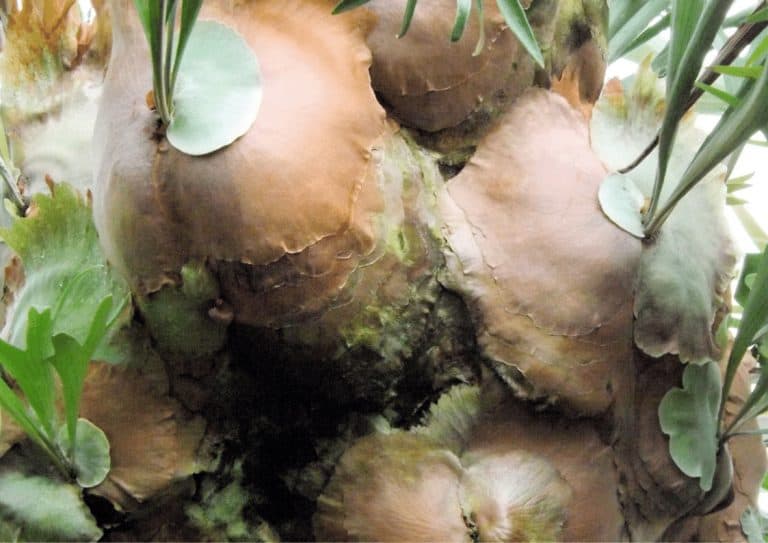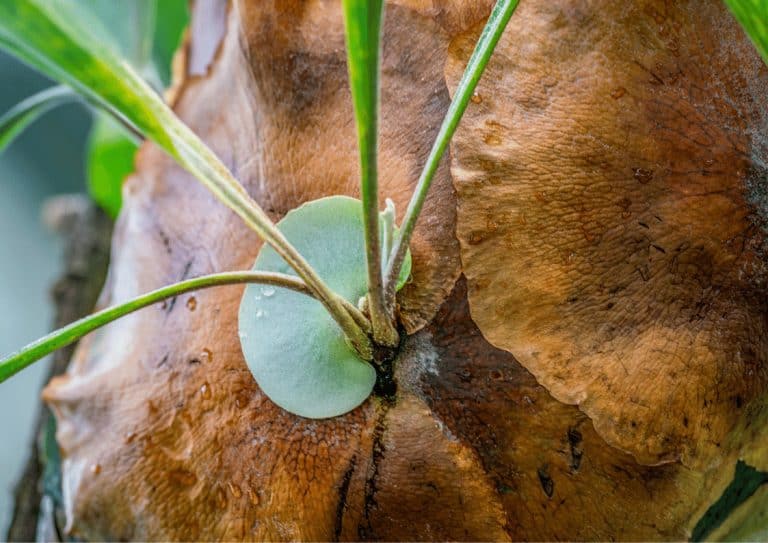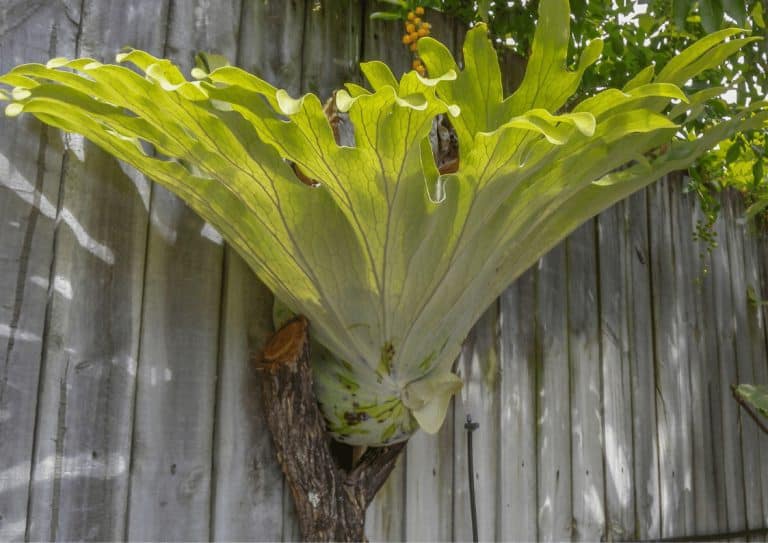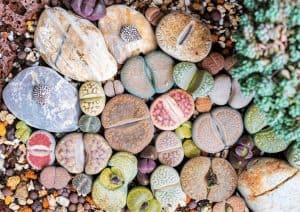My Staghorn Fern Shield Frond Is Brown – Is This Normal?
- Lakeisha Ethans
- July 23, 2022
If you buy something using the retail links in our articles, sometimes we earn a small affiliate commission. This does not impact the products we recommend.
Staghorn ferns (also known as Elkhorn ferns) have two different kinds of fronds or leaves – one is known as the antler frond or the fertile frond, which is responsible for the plant’s reproduction and growth. It is these antler-shaped leaves that give the fern its name.
The other type of leaf is called the shield frond, sterile frond, or basal frond. These types of fronds form a flat disc around the base of the fertile frond and hold structural and survival importance for Staghorn ferns.
As such, it can be worrying to see them start to turn brown, as in most cases, browning leaves is a sign that a plant is unhealthy or dying.
In most cases, shield fronds turning brown on Staghorn ferns is completely normal and natural, raising no cause for concern. These fronds slowly change color as a result of the plant’s natural growth cycle. If there are any negative reasons for the browning of these fronds, they will usually be accompanied by other clear symptoms which are expressed by the fertile frond also.
When shield fronds turn brown, they appear to die and become more and more wilted over time. While it looks concerning, this is completely normal, and this article aims to help you understand that.

Why do Staghorn fern shield fronds turn brown?
Most plants undergo a regular growth cycle that involves the slow and steady aging of current foliage, and Staghorn ferns are no exception. Their shield fronds start out green and fresh, but over time grow old and turn brown as a part of this natural cycle. Shield fronds will begin to brown after a maximum of a year, but some start to turn sooner than that.
In the wild, shield fronds serve the purpose of providing support to the rest of the plant. They hold up the fern against trees, keeping them intact and growing safely.
These hardy, cup-shaped leaves also help the plant by holding onto debris, dead leaves, and other decomposing matter that can be used as a nutritional source for the Staghorn fern.
As they turn brown, shield fronds also become a source of minerals and nutrients to the rest of the fern.
Meanwhile, new frond growth begins to sprout beneath them. The hardier brown fronds serve as a protective “shield” for fragile new growth while providing the plant extra nutrition to further spur healthy development.
This is crucial to the plant, as it allows new growth to stay moist until it can grow roots on its own.

Should I remove brown shield fronds from my Staghorn ferns?
Since shield fronds are important to survival in the wild for Staghorn ferns, you may be tempted to remove them in a domestic environment. After all, you are present to ensure that the fern receives much-needed care, so are these fronds really necessary?
Simply put, you should not remove brown shield fronds from your Staghorn ferns. They may appear unsightly, but they serve the same important purpose to the plant indoors as they do in the wild. When the plant is ready to be rid of them, shield fronds will drop or decompose on their own.
Brown shield fronds supply your Staghorn fern with the nutrients it needs to sustain new growth while protecting that growth from harm. Depending on how you’ve mounted your fern, these fronds may also be crucial in supporting the plant. The fronds also keep your plant’s root ball moist so your ferns get enough moisture.
What should I do if I’ve already removed brown shield fronds?
If you’ve removed shield fronds before realizing their importance, don’t panic. While they are an essential part of a Staghorn fern’s growth and health, you can make up for the mistake by being extra careful and attentive with your plant until new fronds grow in.
The first thing you must be sure of is that your Staghorn fern does not become dehydrated. Keep a close eye on the plant’s root ball and the state of the fertile fronds and water your plant frequently, especially when you notice new shield fronds starting to grow in.
Next, be aware that without their shield fronds, Staghorn ferns may begin to dislodge their growing medium and may be less stable when mounted. If this is the case, use more growing medium to pack the space around your fern’s roots to keep them tight and in place.
Keep in mind that Staghorn ferns have modified roots, not “true” roots. They can become easily displaced if not well supported. If you notice loose growing medium or soil falling from your Staghorn fern while it is without shield fronds, quickly pack it in more tightly.

Should I ever worry about brown shield fronds?
For the most part, brown shield fronds are completely normal and are not a cause for concern. However, that does not mean that there are no exceptions to the general rule. In rare circumstances, they can be an indication of a deeper problem. The good news is that in most of those rare cases, there will be additional symptoms on your Staghorn fern that makes the problem easy to identify.
The most common issue to look out for is underwatering. Staghorn ferns that lack sufficient moisture will begin to develop fuzzy brown spots. These spots will begin at the tip of the frond and then progress downwards and closer to the stem over time, eventually taking over more of the fern. This is because the tips of leaves tend to lose moisture first.
If you notice this pattern emerging, pay attention to a few factors. First, check if the antler fronds of the Staghorn fern are also turning brown. If so, underwatering is the likely issue. Secondly, consider the frequency of your fronds turning brown. If young fronds are turning brown or if more fronds are brown than green, you likely need to give your fern more moisture.
Underwatered Staghorn ferns will likely need to have their root ball immersed in water for five or so minutes. Leave the ball immersed until all roots appear saturated, but for no longer than 15 minutes. You should also be regularly misting your ferns, focusing on the underside of the plant as you do so.
A less common issue to be aware of is fungal infection, which happens due to overwatering. Staghorn ferns that are overwatered will have brown spots that slowly turn black over time. Usually, only a few fronds will show signs of the infection at first. These leaves must be removed from the plant to prevent the spread of the infection.
To avoid overwatering, simply allow your Staghorn fern’s root ball to completely dry out in between heavy watering sessions. If you live in a very humid area or your plant is often exposed to rain, you may even need to forgo practices like misting.
Take home message
Brown shield fronds are completely natural and are a part of a Staghorn fern’s natural growth cycle. Shield fronds provide valuable support to the rootless plants as they adhere to trees, and they also help to trap nutrients and moisture that the fern plant can easily use. These fronds also protect new growth.
This means that brown shield fronds should be left alone to drop or decompose on their own. If removed before they’re ready, you’ll have to be extra careful to ensure that the plant remains supported and that its new growth can develop successfully to prevent damage to your fern.
If you’re concerned about brown shield fronds, pay attention to classic signs of overwatering and underwatering. But in most cases, the color of these fronds is no cause for concern!

Lakeisha Ethans
Houseplant Writer
Mother to two humans and hundreds of plant babies. Lakeisha uses her 15 years of experience as a content writer to specialise in simplifying what you need to know to grow and care for all indoor plants.
Similar Posts
Pruning Your Monstera Plant: Tips for Growth and Disease Prevention
Pruning your Monstera plant can be intimidating, but it's essential for its health and appearance. Follow these simple steps to keep your Monstera thriving.
Patience Is A Virtue: How Long Do Lithops Take To Grow?
Lithops plants can live for a very long time, but how long do they take to grow? How long can you expect to wait before your Lithops is mature?



